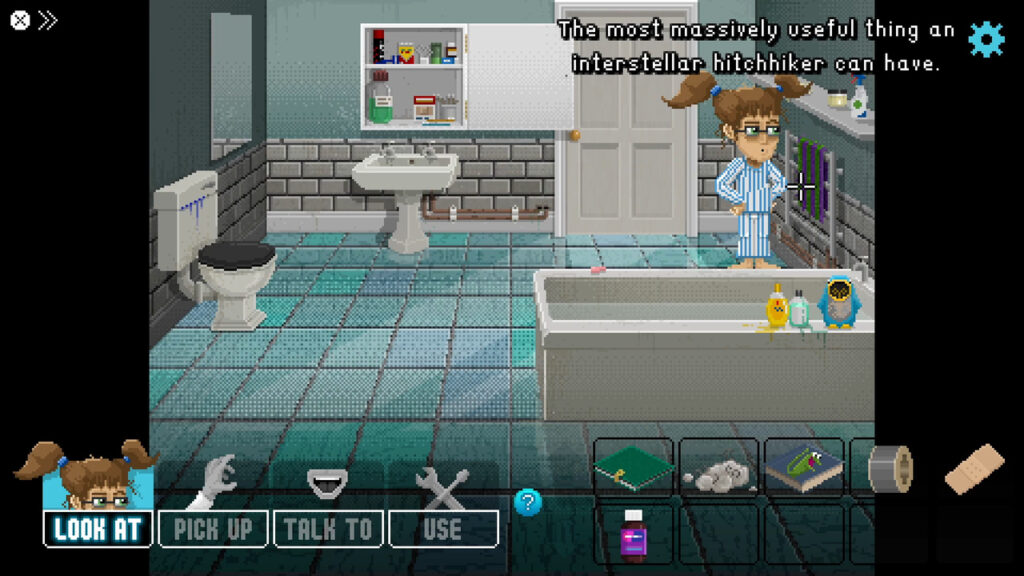
Developer: Tall Story Games
Publisher: Tall Story Games
Platform: Switch (2), PS4, PS5, Xbox One, Xbox Series X|S, PC
Tested on: Switch 2
Lucy Dreaming – Review
It has been a while since the last time we brought you a backlog review, our irregular feature where we take a look at titles that slipped through the cracks of our busy review schedule. This time, we’re going back all the way to 2022 -and technically, even further, as the game in question, Lucy Dreaming, pays homage to 90s PC games. Usually, our backlog reviews only go back a couple of months, so why are we looking at a game that is three years old? Well, the game arrived on PlayStation fairly recently, although that is decidedly not the version we’re taking a look at. Instead, our dream box of choice was our trusty Switch. Your experience will be pretty much the same, regardless of platform. What does that experience entail? We’ll tell you all about it.
Story
Observant readers among you have already noticed that the game’s title hints at the central theme of the story: lucid dreams. When we first meet the titular Lucy, a 13 year old girl, she’s plagued by recurring nightmares where she experiences falling endlessly through the sky. Determined to rid herself of these nightmares, Lucy decides to take control of her dreams. With the help of a psychology book her father gives her, Lucy creates a dream box, which allows her to control certain aspects of her dreams. By putting items in the box, she can enter different dream worlds. While navigating her dreams, Lucy uncovers clues that hint at a deeper mystery in her waking life: A murder occurred in the town of Figgington years ago, and Lucy believes there’s more to the story than the widely accepted explanation of a family dispute over land. Although the story isn’t afraid to take dark turns and touch upon heavy themes, things are handled in a light-hearted manner, with quirky, humorous characters and settings. The narrative is infused with the kind of British humor we’ve come to know and love in Thank Goodness You’re Here!.
Graphics
Taking cues from classic point-and-click adventure games, like Monkey Island, Lucy Dreaming brings its dream world to life with charming, nostalgic pixel art. The game’s colour palette is deliberately muted, giving it an overall bleak and gritty feel, particularly in the real-world locations, but this is balanced out by the overall charm and humor of the game. The various dream worlds are notable for their surreal and whimsical designs, including a bizarre comedy club, a fish-themed world, and an alternate version of Frankenstein’s castle. These locations are highly creative, with quirky visual details that match the humor and tone of the game. The high level of detail doesn’t stand in the way of Lucy Dreaming’s performance either, and the game runs seamlessly.
Sound
Although Lucy Dreaming’s visuals emulate the golden age of ‘90s point-and-click adventures, the game’s soundscape feels decidedly more modern. The standout highlight is that the game features full voice acting. We wouldn’t have it any other way, as the entire cast does a stellar job, elevating both the game’s humor and the overall feeling of immersion. Lucy in particular stands out, as she breaks the fourth wall with witty and sarcastic remarks, delivered in a northern English accent. Sound effects and ambience add even more depth to Lucy Dreaming’s soundscape, with each dream world having its own distinct, immersive audio “language”. When it comes to music, Lucy Dreaming reaches for that 90s nostalgia again, with playful and whimsical music that mimics the sound of old school PC games. You can even swap between AdLib and Roland MT-32 soundtracks, a nod to early sound card technology. It’s small touches like these that make Lucy Dreaming feel like a true love letter to a bygone era.
Gameplay
When it comes to gameplay, Lucy Dreaming doesn’t try to reinvent the wheel and sticks close to the classic point-and-click structure that has been around in one form or another for decades. We won’t go over the basics of the genre again -you should know these by now- but there is one mechanic in particular that is worth zooming in on: Lucy’s dream box. By adding various items to this, Lucy can enter different dream worlds, each with unique puzzles to solve. The dream box mechanic introduces a fun layer of experimentation, as changing the contents of the box affects the dream world, with mixing and matching different items creating all sorts of wacky and unexpected scenarios. Putting a joke book in the box opens up the comedy club, and adding one of her toys, like her teddy bear, adds that character to the setting. The waking world and dream world are tied together not just thematically, but mechanically as well: Lucy often has to change something in the waking world, like adding an item to the dream box, and then return to the dream world to see the effects of her actions. This cross-dimensional problem-solving adds depth to the puzzle design.
If you, like us, grew up with Humongous Entertainment’s point-and-click games, you’ll particularly enjoy how many “clickables” there are littered across each screen. We were caught off guard by just how much we enjoyed randomly interacting with objects, just to see what happened -something that was our favourite part of Freddi Fish or Putt-putt. The kind of jokes that Lucy Dreaming throws at you with these wouldn’t fly in either of the aforementioned titles, but even then, this feature hit us right in our nostalgic feelings. Now, we can’t deny that a good chunk of what we adore about Lucy Dreaming is tied to that 90s nostalgia, but that is undeniably part of the appeal.
If we do remove those rose-tinted nostalgia goggles, however, we have to admit that the old school point-and-clicks that Lucy Dreaming takes inspiration from weren’t without fault. Old-school point-and-clicks are notorious for their obtuse, out-of-the-box puzzle solutions, leading to frustration, especially in pre-internet times when you couldn’t just look up what to do next. It’s refreshing to see that Lucy Dreaming doesn’t emulate that specific quirk. The puzzles are logical, at least within the context of the game’s different worlds. If you do happen to get stuck, there’s a helpful hint system that guides you without outright spoiling the solution: relevant interactable objects are highlighted, ensuring you don’t miss anything important, but avoiding giving away too much at once. The game also has a world map feature, which allows you to fast-travel between locations you’ve already visited, preventing unnecessary backtracking and making exploration more efficient. With a runtime of 8-ish hours, Lucy Dreaming is a short and sweet experience. It’s a fairly standard length for a point-and-click adventure. The game’s modest price point of €16.99 reflects this, and even then, we’d say that in this case it’s a clear example of quality over quantity.
Conclusion
Inside Lucy Dreaming’s dream box, you’ll find old-school gameplay and a slightly-darker-than-expected story, all neatly wrapped in British humor. This is a delightful little game that effortlessly balances nostalgia with modern polish. If you missed out when the game debuted, then this is your sign to pick it up anyway. Just don’t repeat our mistake and have it sitting in your backlog for three years.









No Comments